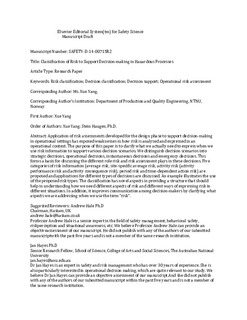| dc.contributor.author | Yang, Xue | |
| dc.contributor.author | Haugen, Stein | |
| dc.date.accessioned | 2017-10-24T09:18:02Z | |
| dc.date.available | 2017-10-24T09:18:02Z | |
| dc.date.created | 2015-08-27T13:31:30Z | |
| dc.date.issued | 2015 | |
| dc.identifier.citation | Safety Science. 2015, 80 115-126. | nb_NO |
| dc.identifier.issn | 0925-7535 | |
| dc.identifier.uri | http://hdl.handle.net/11250/2461677 | |
| dc.description.abstract | Application of risk assessments developed for the design phase to support decision-making in operational settings has exposed weaknesses in how risk is analysed and expressed in an operational context. The purpose of this paper is to clarify what we actually need to express when we use risk information to support various decision scenarios. We distinguish decision scenarios into strategic decisions, operational decisions, instantaneous decisions and emergency decisions. This forms a basis for discussing the different role risk and risk assessment plays in these decisions. Five categories of risk information (average risk, site-specific average risk, activity risk (activity performance risk and activity consequence risk), period risk and time-dependent action risk) are proposed and applications for different types of decisions are discussed. An example illustrates the use of the proposed risk types. The classification has novel aspects in providing a structure that should help in understanding how we need different aspects of risk and different ways of expressing risk in different situations. In addition, it improves communication among decision-makers by clarifying what aspects we are addressing when we use the term “risk”. | nb_NO |
| dc.language.iso | eng | nb_NO |
| dc.publisher | Elsevier | nb_NO |
| dc.rights | Attribution-NonCommercial-NoDerivatives 4.0 Internasjonal | * |
| dc.rights.uri | http://creativecommons.org/licenses/by-nc-nd/4.0/deed.no | * |
| dc.title | Classification of risk to support decision-making in hazardous processes | nb_NO |
| dc.type | Journal article | nb_NO |
| dc.description.version | acceptedVersion | nb_NO |
| dc.source.pagenumber | 115-126 | nb_NO |
| dc.source.volume | 80 | nb_NO |
| dc.source.journal | Safety Science | nb_NO |
| dc.identifier.doi | 10.1016/j.ssci.2015.07.011 | |
| dc.identifier.cristin | 1260319 | |
| dc.relation.project | Norges forskningsråd: 228237 | nb_NO |
| dc.description.localcode | © 2015. This is the authors’ accepted and refereed manuscript to the article. LOCKED until 5.8.2018 due to copyright restrictions. This manuscript version is made available under the CC-BY-NC-ND 4.0 license http://creativecommons.org/licenses/by-nc-nd/4.0/ | nb_NO |
| cristin.unitcode | 194,64,55,0 | |
| cristin.unitcode | 194,64,20,0 | |
| cristin.unitname | Institutt for produksjons- og kvalitetsteknikk | |
| cristin.unitname | Institutt for marin teknikk | |
| cristin.ispublished | true | |
| cristin.fulltext | original | |
| cristin.qualitycode | 1 | |

